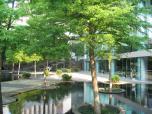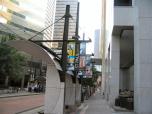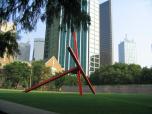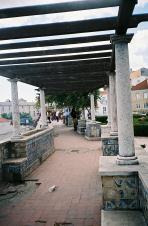




Park Cities Presbyterian Church has a vision to enable Christians and the church to recapture the arts for the role of shaping the culture of society for now and the future. The church has an annual concert series and a thoughtful arts program that is woven throughout its ministries instructing both children and adults about the majesty of God and the beauty of His creation. Each year since 2007, the church has held an art show, enabling artists throughout Dallas and beyond to submit their work based upon a theme that the church selects for that year’s program. The theme for this year’s show is The Passion And The Promise. Submitted material may include original, handmade works on canvas, water media on paper, pastels, drawings, fabric, sculpture, photography, mixed media and short film. I sat down with Lawan Glasscock a few weeks ago who fulfills the administrative role of Strategic Planning and Outreach, Artist Ministry/Patronage, Officer Training and Shepherd Leadership at Park Cities Presbyterian Church, to discuss the church’s vision for this show and the arts in general, as well as how it is impacting the community. This year’s exhibit opens Saturday, March 24 in the main church building outside Fellowship Hall. The address is 4124 Oak Lawn Avenue; Dallas, Texas 75219.
Chuck: Why does PCPC have these annual shows?
Lawan: Park Cities Presbyterian Church has a desire to be a patron for the development of the Christian arts community in Dallas. Our shows we have each year are an opportunity for the church to reach out to a secular audience. We have had speakers in connection with every show. They have included the director of the National Endowment for the Arts, and the U.S. ambassador to UNESCO. The speakers have helped Christians to understand that you can be in the world and yet shape it as Christians. To the secular audience it shows respected people who have helped to shape culture who have also been Christians.
Chuck: Which churches or art programs inspire PCPC in its conducting of this annual show?
Lawan: Fellowship Bible Church in Little Rock was the source of the church’s inspiration to conduct its initial show in 2007. Pete Deison, who is one of our ministers at Park Cities Presbyterian Church, has had a passion for a renaissance of the Christian arts in the church. He visited an arts festival at Fellowship Bible Church in Little Rock, while staying with a friend in 2005. When he returned to Dallas, he was inspired that our church should conduct a similar show, using Psalm 23, the same theme as the show he attended in Little Rock. During 2006, our leadership prayed and planned this festival and it was conducted in 2007. After that time we developed our own model for our shows.
Chuck: How is the show at PCPC unique?
Lawan: Because we embrace every artist. We do not require them to be a believer but we do expect them to read the scripture assigned to that particular year and explore what that scripture means to them and how it inspires them to create. It is a JURIED show that searches for quality. We are not your grandmother’s church festival that accepted any and every entry no matter the quality. This is a serious and professional show that attempts at pulling in the most well-versed speakers and artists (not just Presbyterian, but from across the ecumenical Christian spectrum).
Chuck: What has been the most unusual entry into the show in years past?
Lawan: It depends. What one consider unusual may not be unusual for another. There was one entry in the year of Genesis entitled “Things That Kill Us” that was inspired by the scriptures of the FALL. It was a mixed medium piece that composed all kinds of items that this young man had survived in his more “experimental” stage before finding Christ. In the work, there were burned cigarette butts, syringes, all sorts of pills, and other things of that sort. Maybe it is my dark side that can relate to it, but I truly liked the piece. Several viewers commented that it was “disturbing” to them. Sometimes truth is not pretty; but truth is always beautiful. I found beauty in this piece. Others thought it was too odd.
Chuck: Why was the title “The Passion and the Promise” chosen for this year?
Lawan: Each year has a theme. The show began with the 23rd Psalm in 2007, following the church in Little Rock. However, it was soon realized that PCPC wanted to be a leader and not a follower, so we restructured our process and began to focus on long range messages. From that, we began (as the Bible) with Genesis 1-3 to establish the idea of Creator/Creation and give reference to the artist as sub-creator of God in His image. Once that foundation was laid, we went immediately into the teachings of Christ – His Parables. – and explored that Christ was creatively artistic in his way of presenting His message to the people. “Let those who have ears, hear.” With the Parables, it set Christ as an example for both artists and patrons to expect a deeper (not superficial) message in the work they created or collected. It encouraged them to say something without actually saying it. This was the topic that Gregory Wolfe, editor of IMAGE Journal, just spoke on at PCPC in January.
Once the teachings of Christ were set, we proceeded to approach the miracle of His Incarnation (last year) followed by His Death and Resurrection (this year). The Passion and The Promise was chosen as the theme title because it lets us know that because of the passion (pain and suffering) of Christ, God’s promises are kept. Similar to the understanding of Sin and Redemption. Without Sin, Redemption wouldn’t exist.
Chuck: Please explain Park Cities Presbyterian Church’s meaning behind the following categories of “The Passion and the Promise” (a). His Triumphal Entry John 12:12 – 50; (b). His Glorious Cross Mark 14:1 – 15:47; and (c) His Victorious Resurrection Matthew 28:1-20, since artists will be submitting works under these categories.
Lawan: You would get several answers from several people. Like the 100 works of art that will be in the show, every person has a different take on it. That is never more clear than when you see it visually. I think that sometimes people take for granted that others read a scripture the same way as themselves. In reality, this is not so. We each bring our own self into how God speaks to us.
Chuck: How do you define art?
Lawan: Oh, that is the Ph.D. question! It depends. My graduate degree comes from an anthropological and archaeological point of view rather than a fine arts or elitist view. I do not judge the other view, it just isn’t mine. I do, however, distinguish between folk art and fine art. I also distinguish between public and private art, as well as secular and sacred art. So what is art? Well, what isn’t art? I guess it comes from an individual perspective.
Chuck: If the definition of art can be articulated from an individual perspective, then does art have a standard?
Lawan: One might look at the way that Francis Schaeffer put it “What kind of judgment does one apply then to a work of art? I believe that there are four basic standards: (1) technical excellence; (2) validity; (3) intellectual content, the world view which comes through, and (4) the integration of content and vehicle” He goes on to say that technical excellence includes use of color, form, balance, the texture of the paint, the handling of lines, and the unity of the canvas as well as other things. He describes validity as whether an artist is honest to himself and to his world view, or whether he makes his art only for money or for the sake of being accepted. Third, the content again is what reflects the world view of the artist. In describing the integration of content and vehicle, he states that there is a correlation between the style and the content. The greatest art fits the vehicle that is being used to the world view that is being presented. – Francis Schaeffer
I will say this, good art engages the viewer. If the viewer is not engaged, it is not art. For good sacred art, the purpose is to augment one’s worship. It is essential that this category of art gives one hundred percent glory to God and not the artist. Its purpose is to lift our worship to a higher level, not to give kudos to the artist who created the work.
Chuck: While we are speaking about the individual, how does individualism in our culture help or hinder the creation of fine art?
Lawan: I don’t think art can ever be completely hindered. It is what a society does whether one is happy with it or not. I look at the church as being obliged to take an active part in directing the art of a society so that truth and goodness can shine. The church (and its members on individual levels) should be “Culture-Makers” to borrow a term from Andy Crouch who has written an excellent book on that exact subject.
Chuck: Let’s speak for a while about the show’s impact on the Dallas community. How many visitors usually come to your show?
Lawan: Depending on the year, we have had as many as 6,000 within a 12 day period of the show. But most years tend to run around 4,000 for the brief time of the show. This year, we will extend the winners of the show through Holy Week. That will raise our numbers of attendees.
Chuck: What percentage of the works of art are purchased by visitors to the show?
Lawan: It is really incredible, but we have sold up to 40% of the art! That is amazing when you consider that is 4 times the statistics for a commercial gallery show.
Chuck: How does the church split the proceeds from the show with the artists, and do any community groups benefit from the proceeds?
Lawan: The artist receives 75% of the price. The other 25% goes to defray costs with any leftover going toward art programs for children in the West Dallas area.
Chuck: What was the breakdown of the visitors last year as it relates to their geography (Highland Park, North Dallas, Dallas, Dallas/Fort Worth, Texas, etc…); their stage of life (Child, Student, Single, Couple, Family, Retiree); gender?
Lawan: The visitors are mostly adults, and they really come from all over. Lots of young professionals are drawn to the art. It is an excellent opportunity for the “new” collector to begin their purchases. We have one couple that purchases several pieces each year that they give to family members as gifts.
Chuck: How many of the visitors were from PCPC versus non-PCPC?
Lawan: Probably about 50/50. We have people from several other churches and the community that look forward to the event each year. Over 75% of the artists are not members of PCPC.
Chuck: How many of the visitors did not have any church affiliation?
Lawan: I’m not sure. We don’t ask. The artistic community tends to like to be invisible about things like that.
Chuck: How many of the visitors were prominent artists in Dallas; Dallas-Fort Worth, or nationally?
Lawan: Several. We also had gallery owners and designers come view the art.
Chuck: What sort of impact is PCPC having on the greater Dallas area through this art show?
Lawan: Well first of all, there are over 1,500 artists in our database. PCPC is reaching those artists in Dallas who are not being embraced by the traditional church. These are individuals who are out of the box. We are embracing them and showing them respect. We are confirming with them that their gift is a blessing and not a curse. We have formed a Tuesday night group where people can come and partake of a series that functions as both a biblical and an artistic study. In the past, many of these types of studies could go one way or the other.
In our study, Pete and I try not to bias the participants with PCA doctrine but help them explore universal truths within Christianity such as the Trinity and the Holy Spirit. The Holy Spirit moves in the way that an artist does. The Trinity is a perfect equilateral triangle. Every side has a different personality. The Spirit side relates to the artistic and should be respected as much as God and Jesus.
I mentioned earlier that we have brought in some prominent speakers in the past for the PCPC Arts festival who have included the director of the National Endowment for the Arts, and the U.S. ambassador to UNESCO. The speakers have helped our artists and the church community to understand that you can be in the world and yet shape it as Christians. For the secular people in our audience it shows them respected people who have helped to shape culture who have also been Christians.
Chuck: What have been the top things that PCPC has learned from past art shows that it has conducted that it has implemented for this year or will implement in future years?
Lawan: As I mentioned earlier our first show was on Psalm 23. That show in 2007 had 300 pieces of art from 100 artists. It was more like a festival with very inclusive standards – all art. After that show, we asked the professional artists and the feedback we received from them was that they wanted a professional juried competition.
Because a wide range of quality had been submitted for our first show, we were in danger of missing the good pieces that had been submitted. Therefore, after that show we created a book to bring out the best of the 2007 show called 23 on 23: 23 explorations on the 23rd psalm. We did not plan for this, but that book has actually been able to be used as a ministry to Alzheimers patients and shut-ins. The visual speaks to them. Art reaches a part of the brain that the spoken word does not. Art therapy can actually slow the course of Alzheimer’s as I understand it.
When we planned Genesis, our show for 2008 we thought we would set the show in the community and away from the church campus to see how that would impact our attendance. We partnered with Gables for a grand opening of one of their communities in Uptown. What we found out from that experience is that we got a lot of drive-by traffic but lost the church traffic.
In 2009 we did “Parables (Surprised by Truth)” What we had seen in the past shows was that Christians felt compelled to blatantly give you the message in their art instead of you discovering it through the art. We like to encourage them to let Christ be their example. In His parables, Jesus never knocked people in the face with the message. This led to our receiving some wonderful art.
We now embrace the graphic artists. In 2010 the theme was “The Nativity – The Manger, the Magi and The Majesty”. We had a logo competition to design the logo for the show. Before that time, the show had not embraced the graphic artists. This competition allowed us to embrace the graphic artists. Our winner was a college student who was a part-time security guard.
The other main thing we have learned concerns the artists themselves. As we have gotten to know these artists we have found out from a number of them that they often feel out of place if they are Christian. They often feel isolated from the church community. At the same time, artistic friends who are non-believers can exclude them due to their Christianity. The lack of good community that they experience led us to starting this Tuesday night study.
Chuck: What institutions (churches, museums, schools, universities) does PCPC communicate with as it relates to the furthering of the arts in Dallas?
Lawan: We try to communicate our program as much as we can. But unfortunately “communications and PR” tend to cost money of which we have little. I have pulled in the volunteer assistance from friends in the PR industry in past years, but I am careful not to burn them out. We can ALWAYS use help communicating and getting the word out about what we do. CiVA (Christians in the Visual Arts) has been a great partner for us. My story (how I ended up in Dallas to reconcile the arts back into the church – and especially my search for REAL art in the Christian setting) appeared in SEEN Journal. I will also be writing an article for the next publication on the theme of “Face to Face” which will address Eastern Orthodox Iconography. It is exciting because I will cover the life and work of my dear friend, Vladimir Grygorenko, who is a Ukrainian iconography (or iconographic artist) that lives here in Dallas. The Orthodox Cathedral for the South is literally out my office backdoor. One of my favorite escapes is to cross the alley and have a cup of coffee with Vladimir in his studio. It is amazing to watch him work on the different Orthodox churches through America. It is relationships like this that make my job (and life) so wonderful and truly blessed.
Chuck: Where would PCPC like to see this show and its arts program five years from now?
Lawan: We would like to bring respect for Christian art within the secular art world and also restore the respect in the secular art world for Christians and Christian-themed art. We should do everything to the glory of God and do it in the best fashion and quality that we can.
I have been involved in the Vatican and Uffizi museums and have had an interest in art patronage. I really desire to see the church return to being a patron of the arts and culture.
To me literature is the mother of all arts. One should watch the literature of a culture today to see where the visual arts will end up. The progression flows from literature of a culture to its architecture to its sculpture and finally to its painting.
Catholic friends wonder how I can be a Calvinist and be in the arts. I have discussed theology with them and explained that as long as an image is not an idol that it is ok. One should worship Christ and not an idol. We are all sub-creators, made in the image of God. Christ is the biggest icon of all that God created. We are to be like Christ. We desire to embrace, build patronage, build respect in the secular world for Christian artists and then re-engage and see the world filled with transcendent works of art from Christians.
Verses on a Canvas
Posted: February 28, 2012 by Chuck DeShazo
